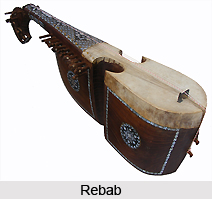 Rebab is a stringed musical instrument closely resembling the Ajanta Veena in India. Though it has its origins in Afghanistan, it is used in a wide variety of musical ensembles and genres, in India. Corresponding with its wide distribution, it is built and played somewhat differently in different areas. This instrument was used in Punjab, but Guru Nanak used it as an accompaniment for Gurumat Sangeet (Sikh sacred music). It was played by his disciple named Bhai Mardana (1459-1519) who originally was a Mirasi (Muslim musician). It is similar to the Rebec of Persia. A number of miniature paintings of Mughal times also show Rebabs of more or less this kind and the Ain-i-Akbari does mention a six-stringed Rebab. The effect of the drum-sound produced by it is very pleasing; it is eminently suitable for devotional music.
Rebab is a stringed musical instrument closely resembling the Ajanta Veena in India. Though it has its origins in Afghanistan, it is used in a wide variety of musical ensembles and genres, in India. Corresponding with its wide distribution, it is built and played somewhat differently in different areas. This instrument was used in Punjab, but Guru Nanak used it as an accompaniment for Gurumat Sangeet (Sikh sacred music). It was played by his disciple named Bhai Mardana (1459-1519) who originally was a Mirasi (Muslim musician). It is similar to the Rebec of Persia. A number of miniature paintings of Mughal times also show Rebabs of more or less this kind and the Ain-i-Akbari does mention a six-stringed Rebab. The effect of the drum-sound produced by it is very pleasing; it is eminently suitable for devotional music.
Construction of Rebab
The Rebab has a piece of hollow wood at the top and a hollow circular wooden belly covered with a sheep skin at the bottom. It has a pear-shaped resonator covered with parchment. There is neck and a short fingerboard without frets. There are two bridges, one in the middle and the other at the tip. The two bridges support six gut strings which are manipulated by six pegs at the top. Some Rebabs have a wooden Toomba (gourd) at the top. It is played with a triangular wooden plectrum. Its sound resembles the human voice and it can play some Gamaks.
Another Rebab, also plucked, is the one with a waist. This instrument, now found only in Kashmir, has a body not with a smooth outline, but with two constructions, one on either side. Besides, the body is deep and extends into a fingerboard. The resonator is parchment covered and bears a thin bridge. There are six strings for playing the melody, corresponding to which are six pegs in the peg box. Usually there are about eleven sympathetic strings Tarab and one Chikari used as the drone. The instrument is held across the body of the squatting musician and played with a wooden plectrum. A very interesting feature is a set of four guts tied across the fingerboard, looking like frets. They are loose enough to be moved, but also fairly tightly tied.




